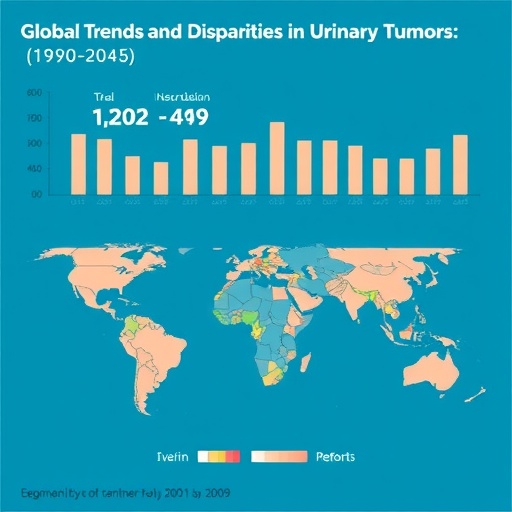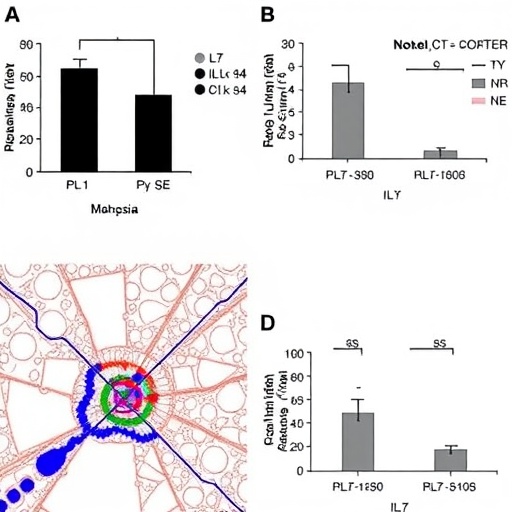
The landscape of global health continues to evolve, revealing troubling trends regarding the burden of urinary tumors. A comprehensive study by Feng et al. delves into the global impact and cross-national disparities associated with urinary tumors, encompassing data from 1990 to 2021 while projecting potential changes in incidence till 2046. This research shines a light on an often overlooked aspect of oncology and public health, emphasizing the urgent need for renewed attention and action in the realm of urinary tumor prevention and management.
The research indicates that urinary tumors have not only persisted but evolved significantly over the decades. The study meticulously chronicles the incidence rates, highlighting alarming trends that reveal the growing prevalence of these malignancies across various geographical regions. Specifically, the research illustrates how the burden of urinary tumors is not uniformly distributed; instead, it underscores stark inequalities that exist between countries and populations, shaped by factors such as socioeconomic status, healthcare access, and lifestyle choices.
During the span of the study, a clear escalation in urinary tumor cases was observed, particularly in low to middle-income countries (LMICs). This spike can be attributed to myriad risk factors such as an increase in smoking rates, changes in dietary habits, and insufficient healthcare infrastructure. The authors argue that these elements combine to create an environment in which urinary tumors can thrive, further exacerbating health disparities globally.
Furthermore, the research team utilized advanced statistical modeling techniques to predict future trends in urinary tumor incidence. Their findings are quite alarming, providing insight into how the burden could change over the next two decades. The projections suggest that if current trends persist, we could see a continual rise in urinary tumors, particularly in emerging economies undergoing rapid urbanization and lifestyle shifts.
An essential component of the research is its cross-country analysis, which offers a framework to understand why certain nations are more affected than others. The investigation not only mapped incidence rates but also associated environmental factors, public health policies, and healthcare access. For example, countries with robust anti-smoking campaigns and early detection programs reported substantially lower incidences of urinary tumors, highlighting the influence of proactive public health strategies.
Moreover, the researchers made a clear call for increased funding into awareness campaigns that educate populations about the risks of urinary tumors, advocating for early detection and effective management strategies. They noted that interventions focusing on lifestyle modifications could be a game changer in reducing the overall incidence of these tumors, particularly in at-risk populations.
The study also emphasizes the role of research and innovation in combating urinary tumors. As science progresses, there’s an urgent necessity to harness new technologies and methodologies that can lead to groundbreaking treatments and preventive measures. The authors advocate for a multi-disciplinary approach that involves oncologists, public health experts, and policy-makers working together to develop robust strategies that directly address the increasing burden of urinary tumors.
In discussing the social determinants of health, the researchers highlighted how economic factors play a pivotal role in determining health outcomes. The correlation between poverty, education, and access to healthcare cannot be understated; it is fundamental in shaping the prevalence of urinary tumors. This underscores the importance of addressing socioeconomic disparities as a means of curbing the rising tide of urinary tumor incidences.
Addressing health equity is not merely a moral obligation but also an essential aspect of public health policy. The study’s insights serve as a clarion call for governments and health organizations to prioritize cancer control as part of their health agendas, especially in regions experiencing rapid transitions that may exacerbate health risks. The need for collaborative international efforts to tackle the inequalities in healthcare access is more pressing than ever.
In conclusion, Feng et al.’s research serves as a critical assessment of the current state and future implications of urinary tumors on a global scale. Their findings challenge stakeholders at all levels to acknowledge and address the discrepancies observed in the burden of urinary tumors and catalyze meaningful change toward health equity. As the world continues to grapple with the implications of these findings, it is clear that urgent action is necessary to stem the tide of urinary tumors and improve health outcomes for vulnerable populations worldwide.
This study not only sheds light on one of the emerging challenges in oncology but also provides a roadmap for potential interventions that could significantly alter the course of urinary tumor incidence in the coming decades. By fostering a multidisciplinary dialogue and investing in comprehensive public health strategies, we have an opportunity to make a significant impact on this growing public health threat.
Subject of Research: The global burden and inequalities in urinary tumors.
Article Title: Global burden and cross-country inequalities in urinary tumors from 1990 to 2021 and predicted incidence changes to 2046.
Article References:
Feng, DC., Li, DX., Wu, RC. et al. Global burden and cross-country inequalities in urinary tumors from 1990 to 2021 and predicted incidence changes to 2046. Military Med Res 12, 12 (2025). https://doi.org/10.1186/s40779-025-00599-y
Image Credits: AI Generated
DOI: 10.1186/s40779-025-00599-y
Keywords: Urinary tumors, global health, public health disparities, cancer incidence, socioeconomic factors, health policies.
Tags: disparities in cancer incidence ratesfuture projections of urinary tumor incidencegeographical disparities in cancer burdenglobal trends in urinary tumorsimpact of smoking on urinary tumorslifestyle choices affecting cancer rateslow to middle-income countries and canceroncology research and public health policiespublic health implications of urinary tumorssocioeconomic factors in cancer prevalenceurinary tumor management strategiesurinary tumor prevention initiatives




